Protein is the most basic building block in a person’s body structure. All your Bones, Muscles, Cartilage, Skin, and Blood will have It allows us to remain thin and physically fit. Your body needs protein to build and repair tissues which allow for faster wound healing. Protein is also essential to make enzymes, hormones, and other body chemicals that are needed to ensure proper bodily functions.
When going on a diet, Protein is one of the most staple food that you should eat. Your diet would rely on specific products with high protein value.
However, before you stuff yourself with Protein, it is important to first understand where it comes from and the specific amount that a person must consume in a day. (1) When we think of Protein, we automatically think of animal meat. While it is correct that Protein mostly comes from meat, there also exists fruits and vegetables that have very high protein content. This is great news for potential vegans and vegetarians who are scared that they will not reach their daily recommended Protein intake just because they swore off meat.
According to health experts, an average adult’s recommended daily amount of Protein is around 0.8 grams per kilogram or 0.36 grams per pound of body weight. (2) If you are looking to gain muscle mass then you would want to consume much more than this. Consuming protein after a workout is essential as it helps build the foundation for muscles.
Increasing your protein intake does not necessarily mean eating more meat. Aside from being expensive, not everyone is a fan of eating animal meat. Fruits and Vegetables also possess a high amount of protein that can help you reach your daily Protein needs. Cheaper but with much more nutritional value, a steady diet of Protein-rich fruits and vegetables has been found to decrease the belly fat while increasing muscle mass. (3) (4) (5). Aside from this, you are generally able to feel more full with protein since they are the most filling and will urge you to eat less, the effect being 441 fewer calories with 15% – 30% more protein (6) (7). This is why a high-protein, low carb diet is recommended for quick weight loss.
Aside from staying lean, the benefits of Protein also include maintaining a better bone structure by having stronger bones. (8) (9). Thanks to this, we are able to have a much lesser risk of osteoporosis as we age (10). Late-night cravings are also reduced thanks to Protein. This would decrease the chances of you stuffing yourself with junk food right before you sleep. In fact, studies have shown that for every 25% of protein, cravings are cut down by 60%. (11)
Fruits may not be as known when it comes to the protein value but there are some with a sufficient amount of Protein that will get you through the day. The added benefit is that there are more Vitamins and Antioxidants as compared to just eating a slab of steak. (12)
Protein Rich Fruits
1. Guava

Guavas are a common tropical fruit that is popular in Central America. It has multiple health benefits aside from Protein which makes it very popular for individuals trying to get healthy. (13)
These include antioxidants, Vitamin C, Potassium, and Fiber. It has an edible seed and is light green in colour. Preparing Guavas can come in many ways, especially since every part of the fruit is edible, even the skin. The Guava leaves can also be steeped as herbal tea or as an extract supplement which also has a lot of health benefits as well. (14)
With very low sugar levels, Guava is good for those suffering from Diabetes and are in need of having their sugar levels lowered through insulin resistance. (15) (16). In fact, a study shows that 20 people who consumed guava after a meal had their blood sugars lowered by 10% (17). Other health factors of your body such as the heart health, proper digestive system, increased immunity, and anticancer effects are beneficial from the consumption of this fruit (18) (19) (20).
Summary
Guava has 2.6 grams of protein per cup.
2. Avocado
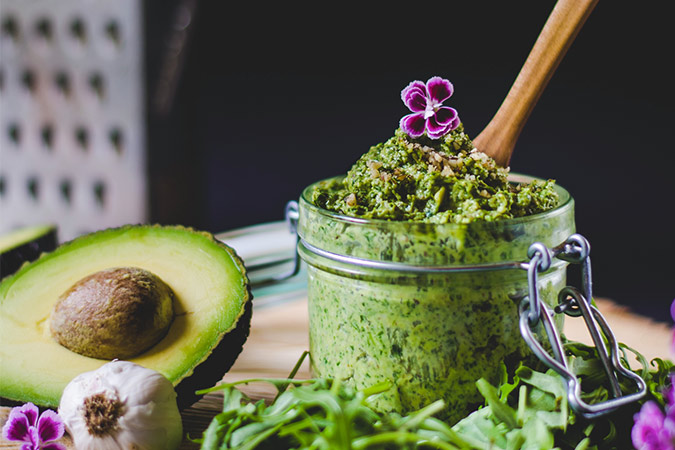
Creamy and delicious, Avocadoes are one of the more popular fruits around the world. Avocadoes may be eaten in itself, blended up into a smoothie, or sliced and added to a dessert.
Avocadoes are known for vegans and vegetarians as one of the better substitutes for meat. Unlike animal-based meats, Avocadoes do not contain saturated fats. Rather, Avocadoes have been found to contain healthy fats which are great for keeping your body healthy. (21) (22)
When discussing fats, people may think that this is unhealthy and makes our bodies prone to weight gain. However, this situation is different for an avocado since the healthy nutritious value is found in the fatty part of the fruit. Aside from healthy links, people are also able to be less prone to cancer cells and high cholesterol levels. (23) (24) (25) This trendy fruit is slowly rising up in demand since there is a variety of recipes you can include this in (26).
As if that is not enough, Avocadoes also have around 20 different vitamins and minerals that you can find within the fruit. (27)
Summary
Avocado has 4 grams of Protein per Avocado..
3. Jackfruit

It might be challenging to find this specific kind of fruit available in the market but when you do find it you should definitely get yourself a piece of Jackfruit. Jackfruit contains a high amount of Protein as well as other nutrients that makes it such a healthy fruit.
It may not be well known but its popularity is steadily increasing due to its nutritional makeup. Originating from South India and making its way around the global market, Jackfruit presents itself with a variety of health benefits. (28) Aside from health factors, the Jackfruit is commonly known for its large size which can reach up until 80 pounds in weight. Due to this, the jackfruit is beneficial in countries such as India that are undergoing starvation (29) (30).
Jackfruit helps protect your body from diseases and oxidative stress which causes inflammation thanks to molecules called radicals (31). Your blood sugar levels are also maintained and controlled since it prevents spiking up of glycemic indexes in the long term. This was proven in a study that was tested on diabetic mice that showed improvement in blood sugar levels after consuming Jackfruit (32). Other health benefits include heart health, healthy skin, and a considerable increase in immunity. (33) There are many jackfruit recipes but you can just eat this fruit raw or cooked, depending on your preference. It can even be bought cut and canned for a more convenient way of consumption.
Summary
Jackfruit has 3 grams of protein per cup.
4. Dried Apricots
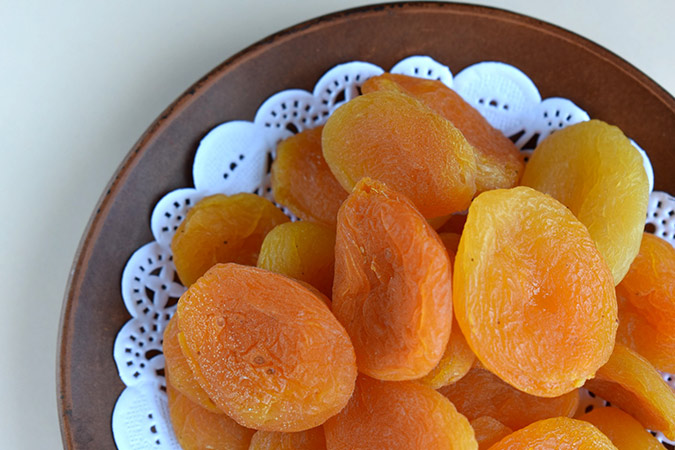
Dried Apricots contain much more protein than fresh Apricots. The drying process concentrates the nutritional makeup of Apricots into a smaller package. The same is true for Grapes and Prunes.
Dried Apricots are packed with antioxidants whose main function is to help your body fight diseases in your body. The list includes carotene, lutein, and zeaxanthin. (34) (35) (36) Antioxidants are an important trait of dried apricots since they protect the body from illnesses and diseases such as diabetes and heart disease (37) (38). These compounds also eliminate those that damage your cells and increase your oxidative stress levels.
Aside from this, your body benefits the intake of Dried Apricots since they help with keeping your skin looking healthy, improving your eyesight, enhanced gut health, liver, and many others. Dried Apricots also has a large amount of Potassium present which allows you more protection from harmful diseases. (39)
Getting hydrated with dried apricots is also easy because despite its name, it still contains a high amount of water. (40) Adding this to your diet is relatively easy and can go even as an after-meal snack.
Summary
Dried Apricots contain 1.4 grams of protein per cup.
5. Kiwi
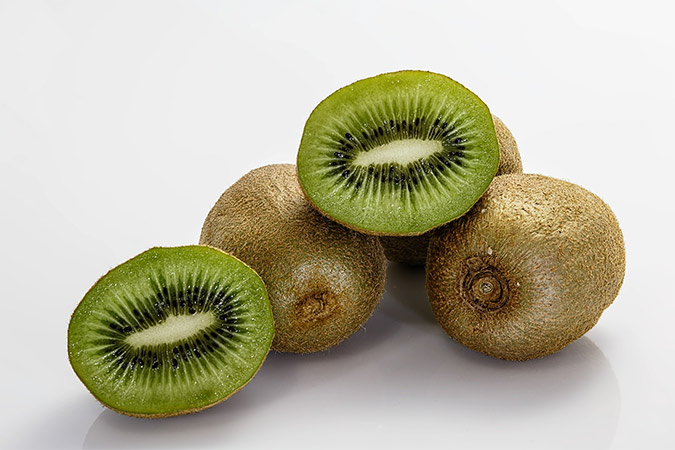
This delicious fruit is famous among many people since it contains a wide range of nutrition as it does flavour. It contains a lot of essential vitamins and minerals that prevent harmful diseases from entering our body.
These include protection from asthma due to the high amount of Vitamin C and Antioxidants making it great for people who suffer from weak lungs. (41) Aside from this, people who usually have problems regarding digestion after a meal will want to have because of kiwi’s actinidin which eases your stomach after eating. (42)
It supports the immune system and prevents illnesses such as flu, colds, and other sicknesses from affecting people especially kids. (43) Kiwis also prevent colon cancer because it helps with oxidative DNA which directly affects your colon.
Your vision will also improve as Kiwis correct vision loss. Consuming Kiwis every day is reported to have decreased the macular loss by almost 36%. (44) You can add this is a shake or a salad, depending on how you prefer.
Summary
Kiwi contains 1.1 grams of protein per cup.
6. Blackberries

During the summer, Blackberries should be everyone’s favourite go-to for snacks. It is relatively easy to include this rich fruits in dessert recipes such as tarts, cakes, and pies.
Aside from their delicious taste, they also come with a lot of health benefits as well. Packed with Protein, snacking on Blackberries can get you through the day. Containing a high amount of Vitamin C, Blackberries can also help you heal wounds through regenerating your cells, absorbing Iron and of course, preventing Scurvy. (45)
Fiber, Vitamin K, and Manganese are other nutrients that can be found in Blackberries. What’s great about this is that consuming one cup of Blackberries are just 62 calories which is an easy burn for your body. (46)
You can boost both your Brain and Oral health due to the nutritional makeup of Blackberries. As if it’s not the perfect snack enough, Blackberries can help you during a study review as it helps you retain more information as well as prevent memory loss. (47) It also extracts the inflammatory causes in your gums, which keep your mouth clean and healthy against all sorts of bacteria (48).
Summary
Blackberries contain 2 grams of Protein per cup.
7. Grapefruit

Grapefruit has earned the reputation of being a healthy food, and it provides a modest amount of protein compared to other fruit on our list. (49) Overall, you’ll be getting plenty of benefits by eating grapefruit, many of which overshadow anything you’d get from its Protein content.
Grapefruit can help with weight loss efforts, and you don’t need to use it as part of any Grapefruit Diet or extreme weight loss plan. A daily Grapefruit in the morning provides you with a good start on your Fiber, while being a low-calorie food and providing you energy to get you through your morning.
In addition to the weight loss benefits and Protein content, Grapefruit is also an excellent source of Vitamin C, like most citrus fruits. This will strengthen your immune system which makes Grapefruit a great snack to have especially when it is flu season. (50)
If you are put off by the sour taste of Grapefruit but don’t want to add refined sugar, you can try adding half a teaspoon of raw, organic honey spread along the top of half a grapefruit.
Summary
Grapefruit contains 2 grams of Protein per cup.
8. Currants

Because of the bright red colour of red currants, you can add a splash of colour to your plate while at the same time adding Protein, Fiber, and important minerals to your diet. (51)
Currants are loaded with Fiber and will help you meet your Fiber needs. It’s important to consider Fiber along with Protein because many high-protein foods contain little to no Fiber. Eating food like currants that is a source of protein as well as Fiber is a great way to supplement your protein intake and help your digestive system function properly.
Currants also provide you with a big chunk of your vitamin C daily requirement and are on par with the kind of vitamin C that you get from an Orange. Because of its size, Currants can be popped into your mouth as a snack or put on top of a salad. They can also be reduced into a jam and put on toast.
Summary
Currants contain 1.6 grams of Protein per cup.
9. Cantaloupe: 1.5g Protein Per Cup (3% DV)
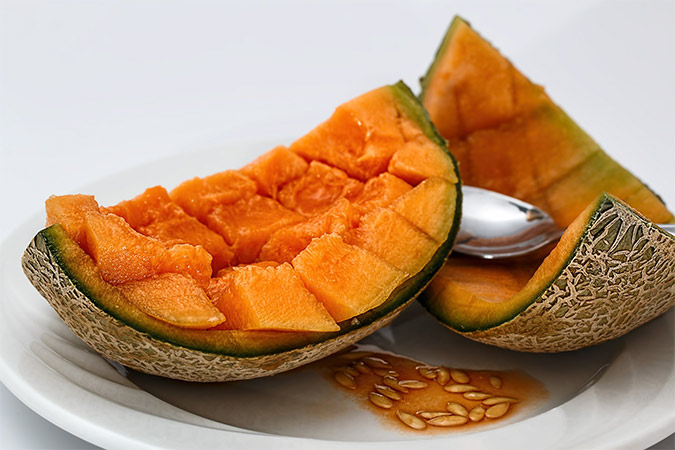
One of the tastier ways to increase your Protein is to have some cantaloupe. Its sweet flavour and soft texture make it a delicious addition to your day, and it has plenty more going for it.
Cantaloupe is high in vitamin A and vitamin C, a duo that really helps out your immune system with two powerful antioxidants that will go to work protecting you from free radical damage. (52)
Because of its orange colour, cantaloupe is a source of beta-carotene, an antioxidant that helps your eyesight as well as your immune system. It also contains some Fiber, to help with your digestive system. (53)
Cantaloupe is a great fruit to eat all summer long. It can be eaten solo or mixed with other melons like honeydew and watermelon in a delectable melon salad that never fails to satisfy.
Summary
Cantaloupe contains 1.5 grams of Protein per cup.
10. Peaches
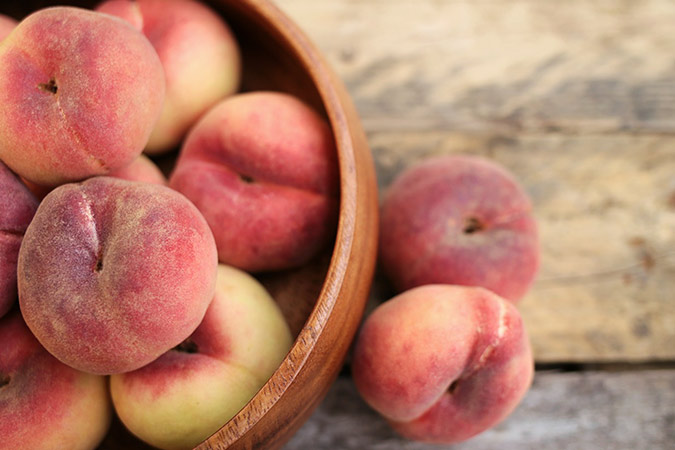
Peaches signal summertime and you can add to your Protein intake by having a peach. Much like the other entries on our list, Peaches brings a lot more to the table than just a Protein. (54) This is really what is great about getting your Protein from fruits and vegetables instead of meat. You are getting much more than just Protein.
Peaches are a source of beta-carotene, which helps with your eyesight as well as your immune system. You can spot beta-carotene foods just by their Orange colour alone. Think of Carrots, Sweet Potatoes, Cantaloupes, etc.
Considered as an excellent source of FIber, Peaches help keep your digestive organs clean and toxin-free. For this reason, you will often see them included in diet and weight loss programs for the natural weight loss effect they provide.
Fresh Peaches can be hard to find especially because they go bad in just a little amount of time. There is nothing wrong with just buying a bag of organic frozen peach slices and add them to smoothies or a bowl of yoghurt for a quick Protein boost.
Summary
Peaches contains 1.4 grams of Protein per cup.
11. Bananas
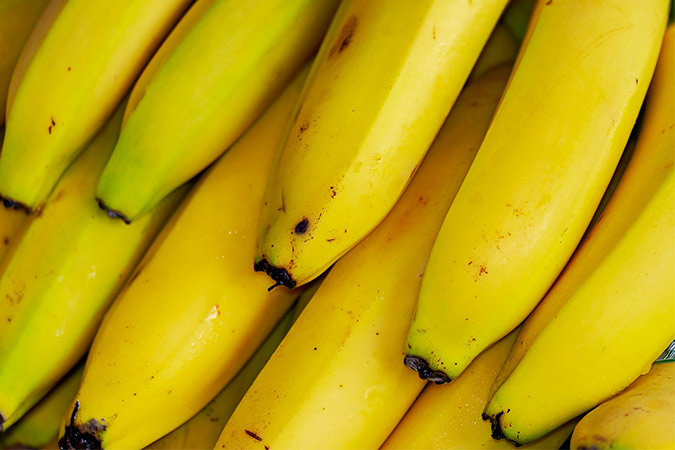
Bananas contain enough protein to make our list of high protein fruits, but keep in mind that they’ll only add a fraction of your total recommended daily value of protein. (55)
It’s the other features of bananas that make them a smart choice as part of a protein-conscious diet. They are well-known for their potassium, which provides you a full 9% of what you need each day. Besides potassium and protein, Bananas will also help you top up your fiber for the day. Enjoying a daily banana can help you maintain a healthy weight, can keep your digestive system moving, and because of the potassium they contain can help keep your blood pressure numbers in line.
Bananas are the ultimate go anywhere snack, and they come with their own portable packaging. They also taste great on a bowl of oatmeal or cereal, or can be added to a smoothie to smooth it out as well as increase its protein.
Summary
Bananas contain 1.3 grams of Protein per cup.
12. Raspberries
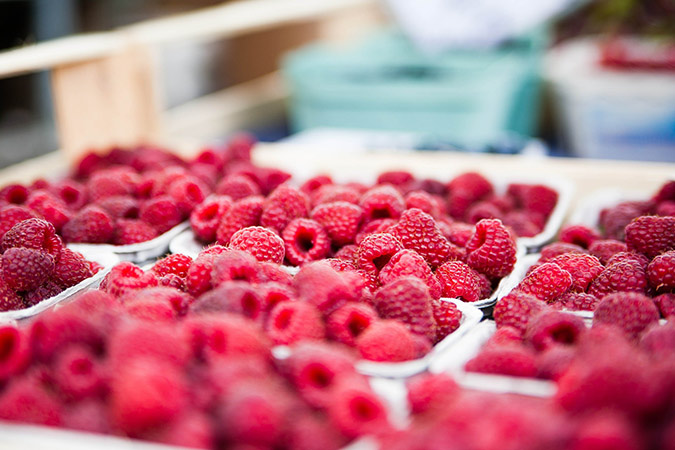
Raspberries may not be bursting with protein, but they will help contribute to your total grams of protein taken for the day, and round you out with an array of vitamins, minerals, and fiber, making them more than worth your while. (56)
Raspberries and other berries made our list of superfoods thanks to the antioxidant value they have, which is important when you’re trying to undo some of the damage done by free radicals. You wouldn’t want to rely on raspberries alone to meet your antioxidant needs, but when combined with other healthy foods they will tip the scales in your favor.
In addition to their Protein and antioxidant content, raspberries are also a respectable source of fiber, so you’re getting at least three great benefits from eating them.
Raspberries go really well with yoghurt, and it makes a great way to start your day off right in the protein department because yoghurt is also a good source of protein. Adding mixed berries as topping for yoghurt would make a great snack or dessert.
Summary
Raspberries contain 1.2 grams of Protein per cup.
Raisins
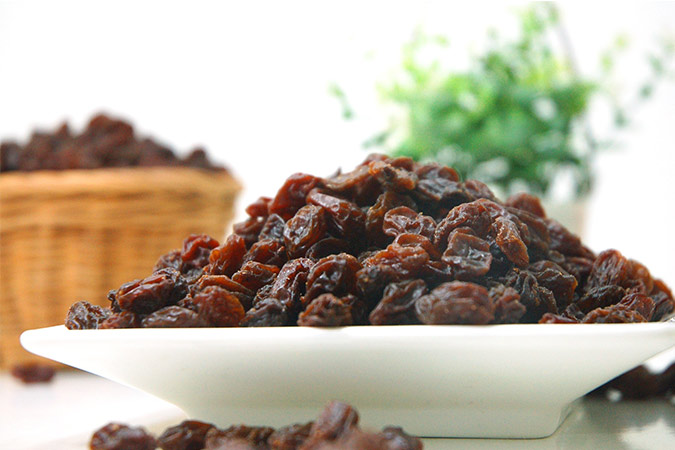
Raisins are easy to eat a lot of, so you’ll pack in more protein by the ounce. Their chewy sweetness is often used in baking and with snacks to provide nutrition, including added protein. (57)
Raisins will help out your digestion, and they’re an often overlooked source of calcium, so you’re getting support for your bones when you eat them. Raisins are also a good source of iron and potassium, and a decent source of fiber. As with dried apricots and other dried fruits you’ll want to be careful with total amount of sugar taken in, as they can contain more sugar than your average fruit.
Add Raisins to Oatmeal or on oatmeal cookies. They’re also easy to take with you and use as a snack whenever you are on the go.
Summary
Raspberries contain 1 gram of Protein per ounce.
14. Prunes

Prunes are known for their Fiber content and their ability to help keep you regular, but they also rank pretty highly in the protein department, for a fruit. Having a few prunes each day is a good habit to get into, but like all dried fruits be sure to limit your consumption due to the high sugar content. (58)
In addition to their Fiber and Protein content, Prunes are also a good source of phenols, which will help you avoid chronic disease and help keep your heart healthy. Their Fiber content will help keep your blood glucose levels stable which helps you maintain a healthy weight, and avoid the onset of diabetes. This is a small fruit with a lot of healthy benefits to it.
Go with whole prunes rather than prune juice, as there is more protein in it, and more potassium. Prunes are easy enough to eat more of because they can be eaten as a snack all by themselves.
Summary
Prunes contain 1 gram of Protein per ounce.
Figs

No matter if you go with fresh figs or dried figs you’ll be getting some Protein from them, as well as other nutrients that contribute to a healthy diet. (59) The main variation you’ll find with figs is whether they’re fresh or dried. Dried figs will provide more Protein per gram, but as with dried fruits, they also contain a much higher amount of sugar which counterbalances the benefit you get from the Protein.
Figs also made our list of foods highest in calcium, and are also a good source of potassium. In dried ,form they are an excellent source of fiber, which will help you feel full and is a great complement to a high-protein diet.
If you’re not used to working with figs it can require a little familiarization, but it is worth the effort. Once you learn how to prepare them, you can use fresh figs in a number of different ways, from salad garnish to an appetizer, and more.
Summary
Figs contain 0.8 grams of Protein per three figs.
Protein Rich Vegetables
1. Peas

Peas are very common and are found almost anywhere around the world. They provide an ample amount of protein needed to get through the day as well as vitamin A, C, and K (60). Although some people, especially those who frequent the gym, would prefer protein shakes rather than peas, a study shows that they both have the same effect on muscle growth (61). By shifting to peas, you will be able to save more money since they cost much less than a protein shake.
WHFoods has recommend to consume at least 8 servings of green peas per day or including it in your weekly meal plan, which can be assessed on your food rating system chart (62). As seen in its nutritional value, there are a number of benefits one may receive from peas. These include anti-inflammatory, blood sugar regulation, and better heart health. Make sure that for the best quality peas, purchase fresh ones that have a harder outer shell to ensure its ripeness.
Summary
Peas have 5 grams of Protein per cup
2. Kale
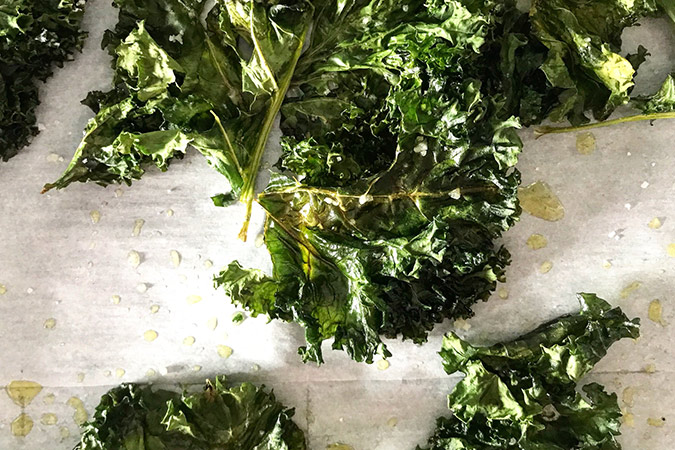
Among all the green vegetables, Kale has one of the healthier and nutritional values. It is known to be the most nutritious dense foods in existence, and it definitely increases the nutrient content once you include them in your diet.
It is very high in antioxidants such as vitamin C, beta-carotene, flavonoids, and polyphenols. (63) Thanks to these, having kale eradicates radicals and oxidative stress from your body, which are also known as the factors that help the body lead up to illnesses such as cancer (64).
Other illnesses that are prevented are depression, anxiety, cancer, and many viruses (65) (66). By having cholesterol levels lowered, you even lower the risks of heart diseases from occurring. This is due to the bile sequestrants that kale releases. A study has found that a person who drinks Kale everyday for 12 weeks has a better HDL (good cholesterol) by 27% and a lowered LDL (bad cholesterol) by 10% while improving antioxidants in the body as well (60).
Summary
Kale has 5 grams of protein per 100 grams
3. Spinach

Spinach is popularly known as the vegetable that increases your strength, but some would often forget the other health benefits that come along with this consumption. It is made up of vitamins and minerals that help reduce oxidative stress, cancer cells, irregular blood pressure, and improves eye health. Some vitamins include Vitamin A, C, K1, Folic acid, Iron, and Calcium (61).
Other plant compounds that are included in spinach are Lutein, kaempferol, nitrates, quercetin, and zeaxanthin (62) (63) (64). These are all linked to the health benefits that it carries which is why it is demanded so highly by the market. Due to the effects of spinach, parents frequent this vegetable because of the many ways to prepare it and its availability in the market (65). Kids are also motivated to eat this vegetable because of its great flavor which makes this a very popular food.
Summary
Spinach has 2 grams of protein per 100 grams.
4. Broccoli
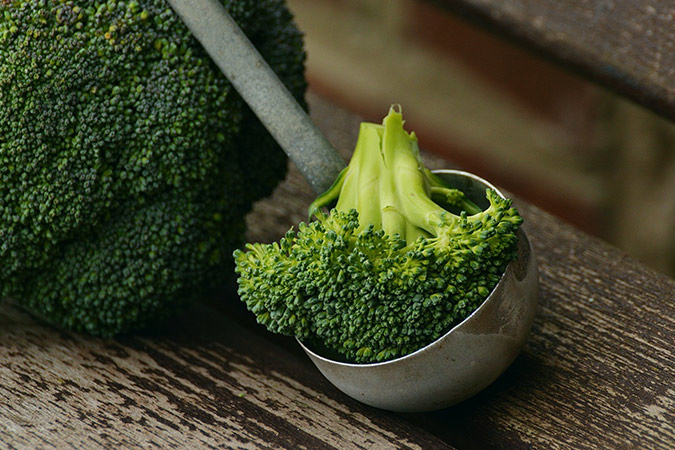
This vegetable is a good nutritional food that is known for its many health benefits that surpass other leafy greens. (66) (67) It only has 31 calories in a cup and is made up of 89% water. Because of this, you can easily consume a lot of Broccoli without having to worry about your weight.
Its carbs consist of fiber and sugar that promotes gut health and weight loss (68). They are also very high in protein, which are the building blocks of your body and make up for your muscle mass. Despite its weight, it gives the body 29% of protein which is greater than most vegetables (69).
The consumption of Broccoli aids a person’s health retention by preventing certain ailments and diseases. These include cancer prevention since oxidative stress levels are limited due to broccoli compounds. Cancers that are prevented are lung, collateral, breast, prostate, pancreatic, and gastric (70). It also helps those who are suffering from high cholesterol levels and are prone to heart diseases. This is because the bile acids are excreted which prevent them from being reused in the body’s system (71).
Summary: Broccoli has 2.8 grams of protein per 100 grams.
5. Asparagus
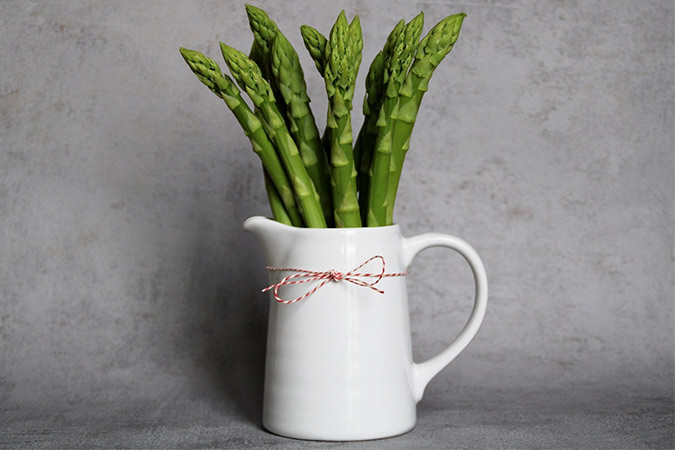
This vegetable is used in a variety of dishes because its flavor balances out other ingredients in the recipe very well. The reason why people frequent this dish is because it is high in nutrients but low in calories. (72) For those who wish to go on a diet, Asparagus is the perfect choice for you since it only makes up 20 calories for every cup. Antioxidants are very much present in this vegetable which can help protect your body from oxidative stress causing cancer cells. (73) Asparagus is known to be anti in terms of inflammation, cancer, and viruses which was proven in numerous studies conducted on both humans and animals. (74)
Digestion is affected positively because of the fiber that it contains, supporting regular bowel movements. (75) When the body needs to detoxify itself, asparagus is the vegetable you’d want to have in your system to aid you faster in this process. This is often served as side dishes in things such as salmon, steak, and bacon. With this, you can get nutritious while having a hearty Omega-3 meal.
Summary
Asparagus has 2.2 grams of protein per 100 grams.
6. Potatoes
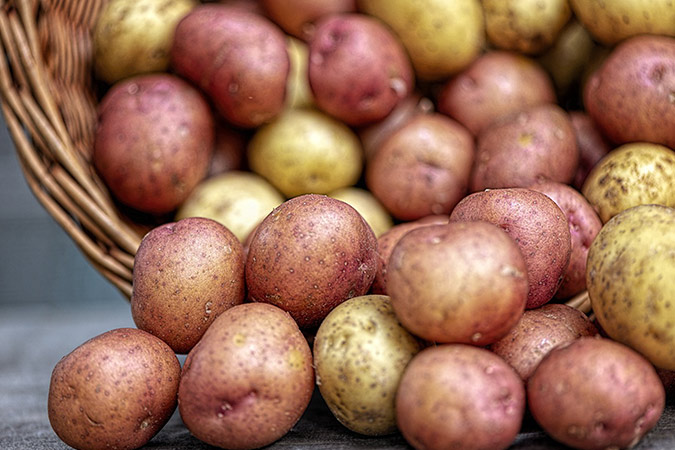
Potatoes can easily go on any meal, making it easy to add to your dietary meal plan. They are very high in water and are packed with nutrients such as potassium and vitamin K. (76) For every 100 grams of boiled potatoes, it is inclusive of 87 calories, 77% water, 2 grams of protein, and .1 grams of fat. The carbohydrates range from 66% – 90% dry weight since they are a source of starch, as well as sugars such as glucose and fructose. (77)
The protein levels are much higher than those of soybeans and legumes (78) called patatin. You can expect to have a better heart health since the compounds in potato lower cholesterol levels and blood levels. (79) Consuming this will also make you feel very heavy, discouraging you from eating other foods which could lead you to gaining unnecessary weight. This being said, potatoes are an excellent source for weight loss since it suppresses your appetite. (80)
Summary
Potatoes have 2 grams of protein per 100 grams.
7. Watercress
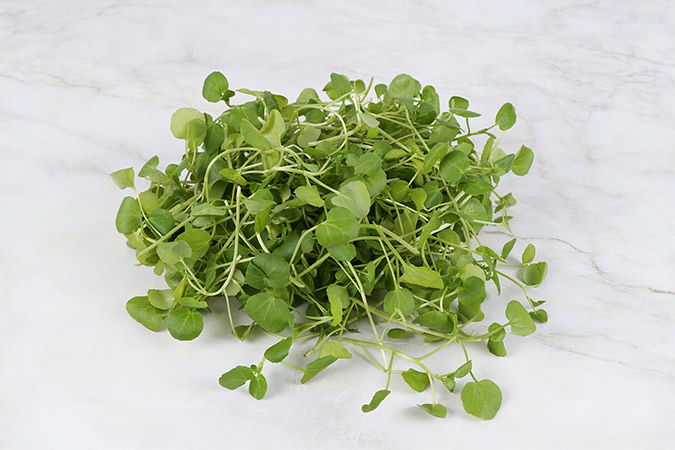
Watercress may not be winning any popularity awards, but it’s high time that it gets more recognition for being a tasty alternative to spinach and kale when you want something a bit different, but still want the benefits of a leafy green.
While it doesn’t quite measure up to Spinach on the Protein scale, it is nevertheless a good source, and offers many of the same benefits as Spinach, albeit on a smaller scale. It has a peppery flavour to it that you simply don’t get from spinach, and is one way to give your palate something new. Watercress is not only a good source of vegetable protein, but it ranks highly in Vitamin C and has a bit of fibre in it as well.
How to eat more of foods rich in Protein: You can use watercress in much the same way you’d use spinach or kale. It works great mixed with other leafy greens in a salad, used in a green smoothie, or all by itself as a salad base.
Summary
Watercress has 2.3 grams of protein per 100 grams
8. Cauliflower

Cauliflower often takes the backseat to broccoli in terms of nutritional awareness, but it contains plenty of benefits and should be added to your diet for all of the good it does. Its protein content may not be through the roof like some other veggies, but it will still help you reach your goal for the day. (81)
Cauliflower possesses antioxidants and has a detoxifying effect on the body, and is part of the cruciferous class of vegetables which includes kale, cabbage, and Brussels sprouts. (82)
These types of vegetables are often lauded for their anti-cancer and anti-inflammatory properties. They’re also known for improving your digestion. There are plenty of unique ways to get more cauliflower into your life. It’s so versatile that it can be minced up into rice-sized pieces as an alternative to rice with more protein per bite. You can also mash it up and create a pizza crust out of it if you’re trying to steer clear of gluten and grains.
Summary
Cauliflower has 1.9 grams of protein per 100 grams
9. Cabbage
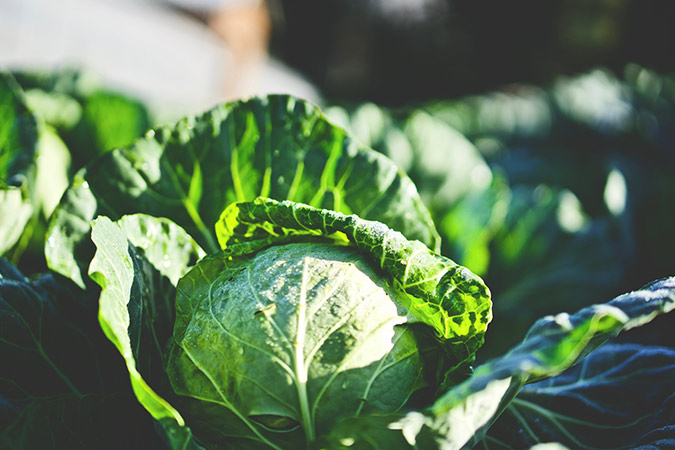
Cabbage is a vegetable whose health benefits are well-known but isn’t often credited for its protein content. It doesn’t contain a large amount of protein, but it is still enough to help the cause.
We normally think of oranges as a good source of Vitamin C and a boost to our immune systems. But cabbage also provides a respectable amount of this important vitamin.
Cabbage is a good source of fibre and is known for its anti-cancer benefits. There’s more than one reason why you should start eating more cabbage, and its protein content pales in comparison to the other benefits it provides.
How to eat more of it: Arguably the tastiest and easiest way to enjoy more cabbage is to make a cabbage soup out of it. This ensures that you’ll be getting fully cooked cabbage, and it will be easier to digest, while still providing some protein, and giving you fibre and other good things for your body.
Summary
Cabbage has 1.3 grams of protein per 100 grams
Conclusion:
Protein is an essential compound that is needed for the body to survive. However, reaching your daily Protein intake should not cost you a lot of money. There are a lot of meat substitutes that you can buy and add into your diet that will not burn a hole in your wallet. Just increasing your Protein intake will definitely make the muscle building process faster for you.


